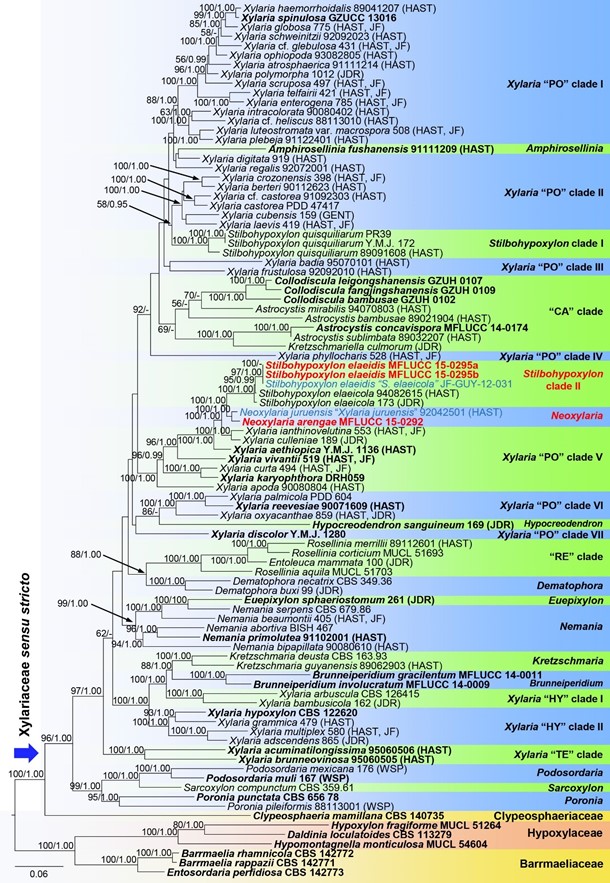Neoxylaria Konta & K.D. Hyde, in Konta, Hyde, Phookamsak, Xu, Maharachchikumbura, Daranagama, McKenzie, Boonmee, Tibpromma, Eungwanichayapant, Samarakoon & Lu, Mycosphere 11(1): 2636 (2020)
Index Fungorum number: IF 556650; Facesoffungi number: FoF 06239
Etymology – In reference to the morphological resemblance to Xylaria Saprobic on palms (Arecaceae).
Sexual morph: Stromata erect, coriaceous, solitary, cylindrical, simple to branched from the base, arising separately or in small bundles, stipe (stem) with brown hairy-tomentose, fertile part, bearing exposed outlines, apex sterile with globose perithecia, free perithecia scattered along with a filiform stroma, arranged in zigzag or in rows, visible as black, thick, surface finely cracked, sterile apex attenuated conical. Perithecia immersed in stromatic tissues, globose, ostiolate with periphyses. Peridium thick-walled, composed of several layers, outwardly, comprising dark brown cells of textura angularis and inwardly, thick-walled, comprising hyaline to pale brown cells of textura prismatica. Ostiole hyaline, papillate, with a central periphyses ostiolar canal and brown to black surrounding disc appear on the surface. Paraphyses hyaline, filamentous, cylindrical, septate, unbranched. Asci 6–8-spored, unitunicate, cylindrical, long pedicellate, apically rounded, with a J+, apical ring, inverted hat-shaped. Ascospores uniseriate, hyaline to pale brown when immature, dark brown at maturity, broad fusoid, unicellular, a lot of small guttules when immature, two large guttules at maturity, smooth-walled, with a straight germ slit throughout ascospore-length. Asexual morph: Undetermined.
Notes – Species of Xylaria cluster in ten subclades in the phylogenetic tree (Fig. 2) indicating that the genus is polyphyletic representing three major clades as Xylaria “HY”, “PO” and “TE”. The type species, X. hypoxylon clusters in Xylaria “HY” clade II which can be regarded as Xylaria sensu stricto. However, it is hard to justify the other clades (Xylaria sensu lato) as new genera without examining old types of these species or obtaining well-defined and identified fresh collections with molecular data.
Type species – Neoxylaria arengae Konta & K.D. Hyde

Figure 2 – RAxML tree based on analysis of a combined dataset of ITS-RPB2-TUB2 sequence dataset from selected species of Xylariaceae. Bootstrap support values for maximum likelihood (ML) greater than 50%, and Bayesian posterior probabilities (BYPP) greater than 0.90 are given at the nodes. Ex-type strains are in bold. Newly generated taxa are in red. The tree is rooted to Daldinia loculatoides (CBS 113279), Hypoxylon fragiforme (MUCL 51264), Hypomontagnella monticulosum (MUCL 54604) (Hypoxylaceae), Barrmaelia rappazii (CBS 142771), B. rhamnicola (CBS 142772), and Entosordaria perfidiosa (CBS 142773) (Barrmaeliaceae).
Species
